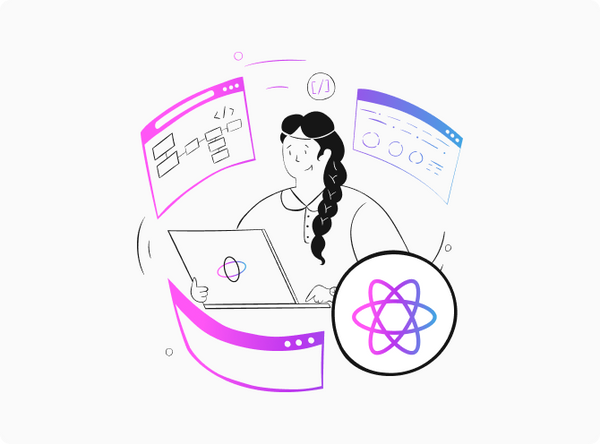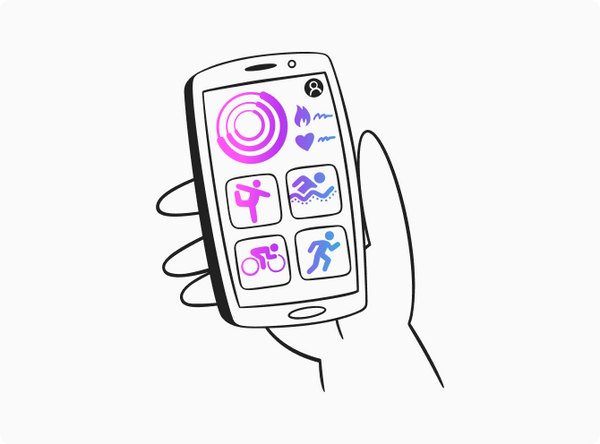
In today's fast-paced digital world, the development of MVPs has become a popular method for startups and businesses looking to launch their products quickly. One of the key elements of MVP development, however, is choosing the right technology stack. And recently, React Native has gained tremendous popularity as a go-to platform for developing mobile apps.
With the ability to deliver native-like performance, this framework has become a favorite among developers and businesses alike. So, let's discuss the main benefits of using React Native for Minimum Valuable Product development and take a look at some settings for which this framework can be a perfect fit.

1. Introduction to React Native MVP
React Native is an open-source framework that was launched by Facebook (Meta) in 2015. One of its main advantages is that it allows for building iOS and Android apps using a single codebase. Aside from Meta themselves, this framework has been used by a number of high-profile companies such as Instagram, Walmart, and Tesla to create mobile products.
It fits well for numerous tasks, niches, and product types, and thanks to its well-developed community and large tutorial base allows even novice developers to get familiarized with it relatively quickly.
2. Key Features of React Native for MVP Development
React Native's capabilities make it a top choice for many small and medium enterprises (SMEs)who are only starting with mobile app development. Here are the main features and benefits that React Native framework brings to the table:
Cross-platform development
One of the biggest advantages of using React Native framework for MVP development lies in its cross-platform nature. With React Native, developers can build apps that work seamlessly on iOS and Android platforms. This is because the framework uses a single codebase that can be used for both platforms, reducing the need for developers to write separate code for each one of them.
This significantly reduces the time and effort required to develop a product, and allows businesses to quickly launch their MVP on both iOS and Android, which is crucial for startups on a tight budget and those who want to reach a broader audience quickly.
Rapid prototyping
React Native comes with a hot-reloading feature that makes it possible to introduce changes to the code in real-time, without having to rebuild the entire app. Not only does it save time for the developers, but also allows them to focus on creating the essential featuresinstead of spending time on routine procedures.
Native-like performance
React Native allows developers to access the native APIs of the device, meaning that the apps built with this framework will have the same look and feel as native apps and offer smooth performance, without lags or delays. This would especially come in handy for startups that not only want to launch fast but build a quality product that can compete with other market offerings.

3. Main Benefits of React Native for MVP Development
Cost-effective development
The ability of the React Native MVP architecture to deliver a mobile application that works on both platforms using a single codebase makes the entire process extremely cost-effective. As a startup, you can save a lot of money on development costs since you don't have to hire separate development teams for both platforms.
Scalability
React Native is highly scalable, making it an ideal fit for MVP development. It uses a component-based architecture, which means that each component is independent and can be easily reused or scaled. In other words, developers can add new features and functionalities without affecting the existing code.
Aside from that, React Native also has a large pool of third-party libraries and tools that can be used to scale the application. They make it easy to add new features or optimize the existing code, which, in turn, makes scaling easier too.
Easy-to-learn framework
React Native is a relatively easy-to-learn framework, especially for those who have past experience working with React. Since it uses JavaScript — one of the most popular programming languages in the world — developers familiar with JavaScript can easily pick up React Native too. On the business side of things, it means that companies can get their MVPs up to speed quickly with the help of this framework.
Large community support
React Native has a large community of developers who contribute to its development and offer support to others. The community is continuously working on new features and plugins for React Native and stays active on various platforms, such as GitHub, Stack Overflow, Reddit, and others.
Not only does it mean that your project can benefit from the knowledge and expertise of other more skilled programmers but also that you can adapt already existing functionality to your project without having to develop everything from the ground up.

4. Real-World Examples of Successful MVPs That Are Built With React Native
The overview of React Native would be incomplete without the real-life examples of successful apps built with the help of this framework. So let's briefly go through the most popular ones.
IGTV (Instagram)
IGTV — short for Instagram TV — is a successful MVP that was launched by Instagram in 2018 using React Native. Until March 2022, the IGTV was distributed as a standalone mobile application enabling users to upload and view long-form videos. The main idea behind this product was to provide users with a new way to interact with content.
Even though IGTV has become a popular app, in 2022, the Meta company shut it down to focus on their new product Instagram Reels. Despite that, the IGTV content and functionality migrated into the Reels, showing that the initial concept had potential.
Discord
Discord is a communication platform designed primarily for gamers that has become a popular place for people to chat and hang out online. Built with React Native, it is available on desktop, mobile, and web platforms, which makes it easily accessible to users.
Discord offers a variety of features, including voice, video, and text chat, making it an all-in-one communication platform. It also has a user-friendly interface, which has contributed to its widespread adoption.
Using React Native, the developers were able to achieve a native-like performance for their Discord app and a 99.9% crash-free rate — all this with just a small team of three iOS engineers.
Uber Eats
Uber Eats is a food delivery app that started as an MVP in Toronto back in 2015 and quickly expanded to other cities. It was built with React Native, which allowed the team to develop the app for both iOS and Android platforms simultaneously. The app's success as an MVP led to Uber integrating it into its main app as a separate feature. The Uber Eats app is a great example of how React Native can be used to build complex applications that require real-time updates and a smooth user experience.
Wix app
In 2016 Wix — a popular website builder — launched its own Wix app, built with React Native. It features a simple and intuitive user interface that makes it easy for users to manage their websites on the go. Users can edit text, add images, and manage their website’s settings from the app. One of the key reasons for choosing React Native for building the Wix app was to ensure that the app was consistent across both iOS and Android platforms.
As a result, developers were able to create a product with a seamless UX that is both intuitive and easy to use. The MVP's success led to the development of additional features, making the Wix app one of the top-rated website builders on the app store.
Myntra
Myntra is an Indian online fashion retailer that launched its mobile app in 2015. The Myntra app — built on React Native — has a wide range of fashion and lifestyle products available, including clothing, footwear, accessories, and beauty products. It has a user-friendly interface, making it easy for customers to navigate through the various product categories and find what they are looking for.
Users can also track their orders, make payments, and get customer support through the app. The Myntra app has become a popular destination for Indian shoppers, and the app has been downloaded millions of times on both AppStore and Google Play markets.
5. Future Trends in React Native MVP Development
ML/AI capabilities
With the ability to integrate Machine Learning (ML) and Artificial Intelligence (AI) algorithms, React Native enables developers to build intelligent and dynamic apps that can adapt to users' needs and deliver personalized experiences. For example, AI-powered chatbots can provide better customer support and improve user engagement while apps that can recognize objects provide users with all the necessary information about the location, building, artwork, clothing, etc.
Integrations with IoT devices
MVPs built with React Native framework can integrate with IoT devices such as home automation systems, fitness trackers, or other wearables. For example, an app that integrates with a smart home device can provide users with real-time updates on the state of their lighting, heating, and security systems, while an app that connects with a wearable device can provide personalized health recommendations based on the collected data. Such integrations can enhance UX and provide real-time data insights about how exactly the product gets used.
Blockchain
By utilizing blockchain integration capabilities, React Native developers can build highly secure and transparent apps that enable payment transactions, digital identity verification, and secure execution of smart contracts. This capability also enables the development of decentralized apps (DApps). Such apps, for example, can provide users with a secure environment for buying and selling goods and services, or be used for voting to ensure fair and transparent elections.
AR/VR
In React Native app development, AR and VR can be used to build products that provide users with immersive experiences, such as virtual tours, gaming, shopping, etc. AR/VR-powered apps can also be used to create realistic environments for users to practice various skills. This is why the use of these technologies have become extremely popular in the healthcare industry in particular for building virtual simulations for study or therapy purposes.

6. How Lunka Tech Can Help in Developing an MVP For Your Project
If you're on the lookout for professional outsource React Native app development services, look no further than Lunka.tech. Our team specializes in the development of mobile applications and web products, as well as MVPs for those.
We work with clients every step of the way, from ideation to launch to make sure that the final result meets their expectations in full. By working with us, clients get:
- A dedicated team of professional software engineers with a proven track record of successfully completed projects;
- A streamlined development process fine-tuned to the needs of the specific project;
- A cost-effective solution for testing and validating your business concept;
- On request, an ongoing support and maintenance for your MVP.
You can reach out to us today to learn more about the MVP app development services we offer and get to know how we can help you accelerate product-to-market delivery and minimize potential risks.
7. Key Takeaways
So, what main benefits of React Native for MVP development do we recommend taking away from this article? First, it's code reusability: developers can write code once and use it across different platforms. Second is native performance: with access to a device's components, a React Native-based product can deliver performance similar to a native app.
Thirdly, it's rapid prototyping — developers can introduce new changes to the product on the go, which in turn reduces the development time. Add to that a huge community support and a large library of third-party plugins and you'll get a perfect framework to start Minimum Viable Product development with.
We hope that this article has answered most of your questions regarding the creation of MVP with React Native. If you want to learn more about the React Native potential for MVP development or simply are looking for a team to get your project up and running, please contact usdirectly!
FAQ
Is React Native still in demand?
Yes, React Native still remains in high demand and is a popular framework option for mobile app development. It has gained significant traction since its release in 2015 and continues to be widely used by developers and companies around the world.
Is React Native good for MVP?
Building MVP with React Native is an excellent choice for several reasons. For one, it allows for faster development times, as developers can write a single codebase that works on both iOS and Android platforms. It's also a cost-effective and easy-to-work-with framework.
How can I effectively plan MVP development using React Native?
First, you need to define the scope and goals of the MVP, i.e. what features and functionalities are essential for the MVP, and set specific goals for the product. Then, identify which tools and technologies, besides React Native, are necessary for you. Once that's done, create a development timeline that would outline all the tasks, milestones, and deadlines for each phase of the process. Once that's done, find a reliable team capable of carrying out MVP development for you.
How do you determine when it's time to move beyond the MVP stage?
Review user feedback and analytics to determine if the MVP meets the needs of users and is generating the desired outcomes. If the MVP has achieved its initial goals, after testing and validation it may be time to start planning for the next development phase.

